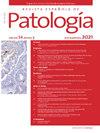GATA-3 biomarker as a confounding factor in a patient with intraocular metastasis from squamous cell carcinoma of the lung
IF 0.5
Q4 Medicine
引用次数: 0
Abstract
Metastatic tumours to the retina are rare and are mainly found in the uvea (choroid, iris, or ciliary body). Despite their rarity, they pose a diagnostic challenge due to their diverse origins and subtle manifestations. This study examines the clinical characteristics and diagnostic challenges of retinal metastases through a literature review and a case involving a 74-year-old male with a painful blind left eye. Initially, the condition was diagnosed as transitional cell carcinoma retinal metastasis based on GATA-3 biomarker expression. Despite multiple examinations, including by retinologists, the finding was incidental, identified by the pathologist without prior suspicion. Through the analysis of clinical and radiological findings, we emphasize the importance of recognizing ocular symptoms as potential indicators of systemic malignancies, particularly in atypical presentations. We highlight the utility of immunohistochemical markers and radiological imaging in diagnosis and treatment guidance. Our findings stress the need for interdisciplinary collaboration between ophthalmologists, oncologists, and pathologists in the management of retinal metastases and thorough anatomical pathology evaluation.
GATA-3生物标志物作为肺鳞状细胞癌眼内转移患者的混杂因素
转移到视网膜的肿瘤很少见,主要发生在葡萄膜(脉络膜、虹膜或睫状体)。尽管罕见,但由于其来源多样且表现微妙,给诊断带来了挑战。本研究通过文献综述和一例患有左眼疼痛性失明的 74 岁男性病例,探讨了视网膜转移瘤的临床特征和诊断难题。最初,根据 GATA-3 生物标志物的表达,该病症被诊断为过渡细胞癌视网膜转移。尽管进行了多次检查,包括视网膜专家的检查,但这一发现是偶然的,是病理学家在没有事先怀疑的情况下发现的。通过对临床和放射学发现的分析,我们强调了将眼部症状作为全身恶性肿瘤潜在指标的重要性,尤其是在非典型表现时。我们强调了免疫组化标记和放射成像在诊断和治疗指导中的作用。我们的研究结果强调了眼科医生、肿瘤学家和病理学家在视网膜转移的管理和彻底的解剖病理学评估方面进行跨学科合作的必要性。
本文章由计算机程序翻译,如有差异,请以英文原文为准。
求助全文
约1分钟内获得全文
求助全文
来源期刊

Revista Espanola de Patologia
Medicine-Pathology and Forensic Medicine
CiteScore
0.90
自引率
0.00%
发文量
53
审稿时长
34 days
 求助内容:
求助内容: 应助结果提醒方式:
应助结果提醒方式:


